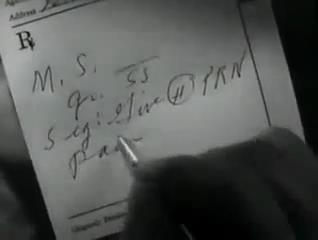X marks the Spot
An abstruse
little film on the war, mirrored in murder over a fortune in tires
“frozen” by the Office of Production Management.
The private dick
gets the girl and is off to the Army as a lieutenant in G-2.
The
Sleeping City

An
undercover cop at Bellevue to ferret out the answer to an intern’s
murder.
A .38 in the
face, the principal basis of Lumet’s Serpico (as Benedek’s Port of New York to Friedkin’s The French Connection, the same
beautiful great city).
This is placed in
the hands of John Alexander as the detective inspector in charge, Alex Nicol as a victim, Coleen Gray
the ward nurse, and Richard Conte out of pre-med and the Medical Corps.
The ending pivots
on The Maltese Falcon (dir. Roy Del
Ruth or William Dieterle or John Huston) toward The Man with the Golden Arm (dir. Otto Preminger).
“There is little”,
wrote Bosley Crowther of the New York
Times, “to distinguish it from any thriller film.” Variety, “actually filmed at
Bellevue.” Leonard Maltin, “earnest”. TV Guide, “surprisingly
intense and disturbing.” Bruce Eder (Rovi), “one of the finest and
most troubling films to come out of Universal-International.” Halliwell’s Film Guide, “of
modest excellence.”
Godard has described the apprehensivemess felt by one hearing
footsteps running toward him in a city, that and a remarkable feint in the
general structure are part of Eisinger and Sherman’s opening scene.
Willie and Joe Back at
the Front
Mauldin’s
dogfaces leave sunny Italy for Stateside business, a service station across the
street from a used car lot, respectively.
They’re
called up for basic training in Japan, go on leave in Tokyo and bust up a
smuggling ring, the goods is explosives.
A work of genius,
the doggies throw the stuff back at ‘em unawares.
Samuel Fuller has
exactly the same idea in House of Bamboo.
Against All Flags
The great joke
very nearly occurred to the New York Times writer, A.W.
That is,
Aureng-Zebe’s daughter.
So, the pirate
captain who calls herself Spitfire is represented by an alter ego, small and
self-possessed, not wearing seven-league boots and a jerkin.
Undercover to
spike the guns of the pirate port, that a British man o’war may enter,
with lashes on his back, Flynn.
O’Hara of
the Shark, Quinn the Scorpion.
welcome
to the wedding
route 66
Something rather
like Frost’s “Love and a Question”, expanded in a crime drama
around two poles, one the brutal convict Lezama (cf. Lang’s The
Big Heat) making his escape at the great Cleveland railroad station, where
not all members of a society wedding are met.
A great
performance by Rod Steiger as the double murderer serving two consecutive
99-year sentences.
Big Jake
In exile (separated from his family), Jake (John Wayne)
intervenes at the lynching of a Scotsman (Bernard Fox) whose only crime is
herding sheep.
In the town of McCandles, whose name is that of Jake (or Jacob),
his ranch has been overrun by marauders. They’ve shot and killed a number
of men, wounded one of his sons, and kidnapped his eight-year-old grandson. The
ransom is one million dollars in $20 bills.
Texas Rangers pursue the gang in REOs and get shot to pieces.
Mrs. McCandles (Maureen O’Hara) asks Jake to haul a box full of money
down to Mexico and bring the boy back.
Jake’s two other sons (Patrick Wayne and Christopher
Mitchum) are fully-grown but immature. They join him on the trek.
Jake’s only companion in exile had been his dog (named
Dog). Now he requests an old friend, the Indian Sam Sharpnose (Bruce Cabot) to
assist.
The gang’s head man (Richard Boone) orders an exchange at
Escadero, an oil-drilling town. After a great deal of agitation (what with
desperados behind them, trailing after the money), a final shootout eliminates
the gang (as well as Dog and Sharpnose). The boy is recovered, the sons are
reconciled to their father, and that’s the end.
It opens, after an overture, exactly like Chisum, with a
view of the green valley and river seen from the ranch house.
The overture consists of a magic lantern show under a rapid
narration by George Fenneman, describing the civilized world of 1909 (The
Edwardians and Einstein, Caruso, Toscanini, the Barrymores, Ziegfeld, President
Taft—“300 pounds of pure Republican”—John Jacob Astor,
Pavlova, et al., with accompanying photographs ultimately spilling out
into The Great Train Robbery).
George Sherman directed John Wayne in the Thirties, also Gene
Autry, among others.